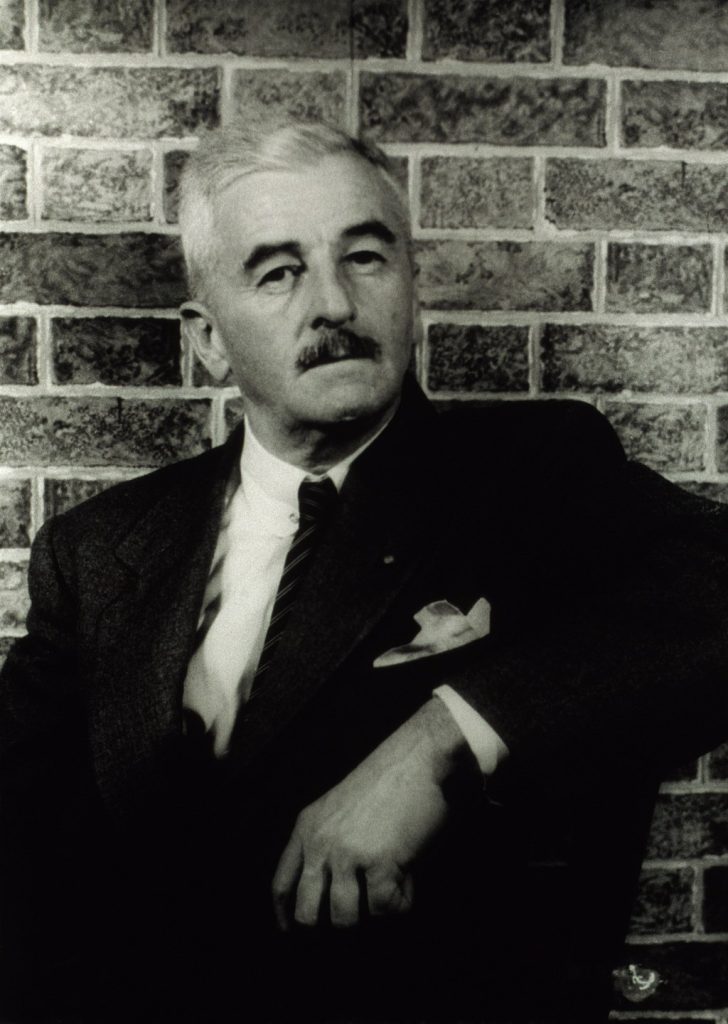3 William Faulkner (1897 – 1962)
Amy Berke; Robert Bleil; Jordan Cofer; and Doug Davis

William Faulkner is the most important writer of the Southern Renaissance. Flannery O’Connor once compared the overpowering force of his influence to a thundering train, remarking that “nobody wants his mule and wagon stalled on the same track the Dixie Limited is roaring down.” Faulkner was born in Mississippi and raised on tales of his legendary great-great grandfather—the “Old Colonel,” who led a group of raiders in the civil war, built his own railroad, served in the state legislature, and was murdered by a political rival—and prominent great-grandfather, the “Young Colonel,” who was an assistant United States attorney and banker. Dropping out of high school, Faulkner left Mississippi to pursue his interests in drawing and poetry. During World War I, Faulkner pretended to be English and enlisted in the Royal Air Force, although he never saw combat. He picked up his poetic career after the war, ultimately publishing his first book in 1924, a collection of poetry called The Marble Faun. Turning his attention to fiction writing, Faulkner then wrote two timely novels. His first novel, Soldier’s Pay (1926), explores the states of mind of those who did and did not fight in World War I. His second novel, Mosquitos (1927), exposes the triviality of the New Orleans art community of which Faulkner was briefly a part. However, it is with his third novel, Sartoris (1929), that Faulkner made what he called his “great discovery”: the fictional possibilities contained within his home state of Mississippi. Returning to Oxford, MI, with his new wife, Faulkner moved into an antebellum mansion and began turning the tales he heard growing up about his hometown and surrounding area into one of the greatest inventions in American literary history: Yoknapatawpha County.
Faulkner eventually wrote thirteen novels set in Yoknapatawpha County. Be- ginning with his fourth novel, The Sound and the Fury (1929), Faulkner began to incorporate modernist literary techniques such as stream-of-consciousness narration and non-linear plotting into his already lofty style. The Sound and the Fury describes the fall of the Compson family through four distinct psychological points of view, one of which is that of a young man who commits suicide, and another belonging to an illiterate who is severely mentally handicapped. As I Lay Dying (1930) describes the death and burial of a matriarch from the perspective of fifteen different characters in fifty-seven sections of often stream-of-consciousness prose. In Absalom, Absalom! (1936), four narrators relate the same story yet also change it to arrive at four very different meanings. Modernist techniques such as these enabled Faulkner to show how the particulars of everyday life in the rural Ameri- can South dramatize what he saw as the universal truths of humanity as a whole. While stylistically modernist, Faulkner’s collective epic of Yoknapatawpha County ultimately explores not so much the future of narrative as the human condition itself as lensed through generation-spanning histories of great and low families. Two of Faulkner’s Yoknapatawpha stories are included here: “Barn Burning,” an early story of the Snopes family about whom Faulkner would eventually write a trilogy of novels; and “A Rose for Emily,” one of his many tales about the decline of formerly-great Southern families. These short stories are good representatives of both the range of Faulkner’s style and his ambition as a storyteller. In deeply regional tales that are at once grotesque, tragic, brilliant, profound, loving, and hilarious, Faulkner leads us to the source, as he once put it, from which drama flows: “the problems of the human heart in conflict with itself.”
Content Advisory
Literature involves language, descriptions, and/or topics that may be emotionally disturbing, graphic, or otherwise sensitive in nature. These topics (or materials) are important to the course as these words, attitudes, and biases are part of American literature and provide us with opportunities to better understand our history and society.
“A Rose for Emily”

Click the link below to access this selection: https://web.archive.org/web/20231017060937/http://xroads.virginia.edu/~DRBR/wf_rose.html

